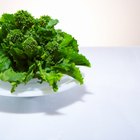
Broccoli is one of the healthiest vegetables out there, containing many essential vitamins and minerals. Certain cooking techniques, however, can diminish its nutritional content. For example, "The New York Times" reports that cooking broccoli in a bowl of water in the microwave can cause the broccoli to lose up to 97 percent of its antioxidant compounds. Raw broccoli maintains all of its nutrition, but if you're going to cook it, choose the healthiest ways. Fresh broccoli only takes a few minutes to cook, so it's the perfect quick-fix vegetable when you're in a rush.
Boiling
When you boil broccoli, it loses some of its nutrients in the water. The longer you cook broccoli, the more it loses. This can make a big difference if you're planning to eat broccoli as a side dish. However, if you're cooking broccoli as an ingredient in soup, the nutrients simply go into the soup broth, so you don't lose them. Soups often simmer for several hours before they are ready to eat, and this will make broccoli too soft. Instead, add broccoli during the last 15 minutes of cooking or blend pureed broccoli into the broth. To add a fresh, zesty flavor, stir some dry salad dressing and seasoning mix into your soup when you add the broccoli. If you decide to boil broccoli as a side dish, use as little water as possible -- don't completely submerge the vegetable.
Steaming
Steaming retains the most nutrition, according to the Bastyr Center for Natural Health. To properly steam broccoli, elevate the vegetable above the water using a steaming tray inside a pan. It should take around 10 minutes to steam broccoli, depending on how soft you like it. If you sprinkle dry salad dressing and seasoning mix on the broccoli before steaming it, the flavors fuse into the broccoli more than if you were to add them at the end.
Roasting
Roasting vegetables does maintain most of their nutritional content. However, Karen Collins, R.D., points out that cooking at such high temperatures for an extended period of time can still cause the broccoli to lose some nutrients, especially when compared to a technique like steaming. To minimize the amount of time that you roast broccoli -- and thus the amount of nutrients it could potentially lose -- try steaming it for a few minutes before you put it in the oven.
Stir-Frying
Stir-frying broccoli allows for minimal nutrient loss. The type of oil you use, however, can affect how much of broccoli's vitamin C, polyphenol and glucosinolate is lost in the cooking process. The Bastyr Center for Natural Health suggests using either extra virgin olive oil or peanut oil when stir-frying broccoli. Cook it for three minutes or less to retain the most nutrients. Briefly stir-fry broccoli with some sliced onions, cauliflower florets and sliced carrots, and serve with a drizzle of creamy fat-free salad dressing for a tender-crunchy side dish.
Cooking in the Microwave
Submerging broccoli in water as you cook it in the microwave causes significant nutrient loss. However, if you reduce the amount of water that you use and cover the container, you are just steaming the broccoli in the microwave, which retains more nutrients. Alternatively, you could microwave frozen broccoli without using any extra water in the process. For an unexpected flavor kick, season broccoli with a dash of powdered salad dressing and dip mix before serving.
Related Articles

Nutrients for Steamed Broccoli

How to Perfectly Cook Broccoli

How to Steam Broccoli Without Making it ...

Ways to Cook Broccoli

How to Broil Broccoli

How Long Does It Take to Steam a Yam?

How to Steam Vegetables in an Electric ...

Does Boiling Carrots Destroy the ...
How to Cook Frozen Broccoli

How to Eliminate Bitterness in Broccoli

How to Freeze Broccoli

Steaming vs. Boiling vs. Baking Carrots

How to Cook Fresh Broccoli in a Slow ...

How to Cook Vegetables Without Losing ...

How to Freeze Fresh Asparagus

How to Dry Broccoli

How to Cook Broccoli Stalks

How to Blanch Bitter Greens for Italian ...

How Long Should You Steam Kale?

How to Cook Romanesco Broccoli
References
Writer Bio
Maggie McCormick is a freelance writer. She lived in Japan for three years teaching preschool to young children and currently lives in Honolulu with her family. She received a B.A. in women's studies from Wellesley College.
Photo Credits
NA/Photos.com/Getty Images